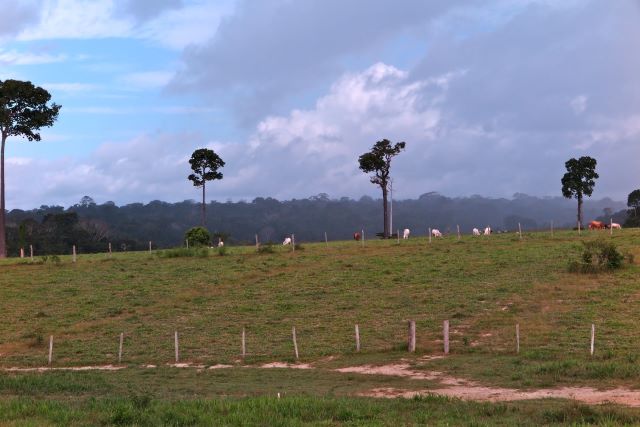

Pasture near area of native forest in Pará, a state in the Brazilian Amazon (photo: Molecular and Cellular Biology Lab/CENA-USP)
Bacteria, fungi and archaea that live in soil act as a methane sink, among other ecosystem services, but deforestation can reduce their functional diversity, Brazilian, British and American researchers warn in the journal Trends in Ecology and Evolution.
Bacteria, fungi and archaea that live in soil act as a methane sink, among other ecosystem services, but deforestation can reduce their functional diversity, Brazilian, British and American researchers warn in the journal Trends in Ecology and Evolution.

Pasture near area of native forest in Pará, a state in the Brazilian Amazon (photo: Molecular and Cellular Biology Lab/CENA-USP)
By André Julião | Agência FAPESP – The Amazon is famous as a plant and animal biodiversity hotspot, but it is also outstanding for the diversity of its microbial life, not least in the soil. Important ecosystem services, such as storage of methane that would otherwise infiltrate the atmosphere, are performed by underground microorganisms.
Substitution of pasture for forest is a threat to bacteria, fungi and archaea. Integrating knowledge of these life forms in conservation, restoration and management efforts is therefore urgently needed to understand and maintain the Amazon.
The argument is defended in an article published in the journal Trends in Ecology and Evolution by a team of researchers affiliated with the University of São Paulo (USP) in Brazil, in collaboration with colleagues at universities in the United States and United Kingdom.
“Microorganisms are extremely important for maintaining macro processes – in this case, the functioning of the forest, the equilibrium between animals and plants, and the ecosystem services of rivers, among others,” says Júlia Brandão Gontijo, co-second author of the article. She conducted the study while researching for a PhD with a scholarship from FAPESP at USP’s Center for Nuclear Energy in Agriculture (CENA) in Piracicaba, São Paulo state, and is currently a postdoctoral scholar at the University of California Davis in the United States.
An issue the group has studied a great deal is the replacement of methanotrophs – microorganisms that consume methane and therefore benefit climate equilibrium – by methanogens – microorganisms that produce methane – when native vegetation is converted to pasture. Cattle ranching is responsible for 87% of land use change in the Amazon.
“An unexpected finding of ours in recent years is that soil bacterial diversity is greater in pasture than in forest. However, when spatial scale is analyzed, the microorganisms found in the soil of pasture are always the same, whereas they vary significantly from place to place in any forest. Conversion of forest to pasture therefore leads to homogenization of soil bacterial communities,” says Andressa Monteiro Venturini, first author of the article, a former postdoc with a scholarship from FAPESP and currently a visiting researcher at Stanford University in the United States.
One of the causes of low spatial diversity of pasture, Venturini explains, is precisely the loss of endemic species of microorganism, which can lead to the loss of important functions such as consumption of methane, a major greenhouse gas.
From sink to source
In previous research reported in Environmental Research and Science of The Total Environment, the group showed that forest to pasture conversion changed the number of methane-producing archaea and methane-consuming bacteria as well as the balance between them.
Forest soils typically act as methane sinks, preventing the gas from rising into the atmosphere. When forest is converted to pasture, the soil contains more methanogens and emits more methane. This change from methane sink to methane source intensifies when the topsoil is removed and lime is applied to reduce soil acidity.
“Land use is important, but soil management is equally so,” says Tsai Siu Mui, full professor at CENA-USP and coordinator of the studies. Another study by her group showed how forest-to-pasture conversion favors an increase in antibiotic-resistant soil bacteria (read more at: agencia.fapesp.br/35345).
These studies and the study reported in Trends in Ecology and Evolution were part of a project funded under an agreement between FAPESP and the U.S. National Science Foundation (NSF) via the FAPESP Research Program on Biodiversity Characterization, Conservation, Restoration and Sustainable Use (BIOTA-FAPESP).
According to the researchers, soil as a greenhouse gas sink is rarely discussed in studies of Brazil’s contribution to global emissions. The topic can be explored in future studies on combining environmental and molecular measures (abundance of genes relating to production and consumption of methane), for example.
The article also argues that an analysis of isotopic data can help identify the metabolic pathways of methane production in the soil, leading to a greater understanding of how microorganisms respond to land use change. Moreover, integration of environmental genomics with bioinformatics and machine learning can help predict and hence prevent soil methane emissions, without losing sight of restoration and soil management strategies.
“Studies in this field could lead to the discovery of microorganisms that are favorable to native crops, such as fruit, that are already grown in the region but lose productivity over time. The search for inoculants derived from the Amazon’s biodiversity, for example, would be one of the possible avenues for new studies that could help build an Amazonian bioeconomy,” Tsai says.
Other co-authors of the study included Jéssica Mandro, who earned a master’s degree from CENA-USP with a scholarship from FAPESP and is currently a PhD candidate there.
The article “Soil microbes under threat in the Amazon Rainforest” is at: www.cell.com/trends/ecology-evolution/fulltext/S0169-5347(23)00111-8.
Republish
The Agency FAPESP licenses news via Creative Commons (CC-BY-NC-ND) so that they can be republished free of charge and in a simple way by other digital or printed vehicles. Agência FAPESP must be credited as the source of the content being republished and the name of the reporter (if any) must be attributed. Using the HMTL button below allows compliance with these rules, detailed in Digital Republishing Policy FAPESP.





